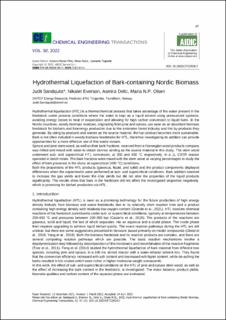| dc.description.abstract | Hydrothermal liquefaction (HTL) is a thermochemical process that takes advantage of the water present in the feedstock under process conditions where the water is kept as a liquid solvent using pressurized systems, avoiding energy losses to heat of evaporation and allowing for high carbon conversion to liquid fuels. In the Nordic countries, woody biomass residues, originating from pine and spruce, are seen as an abundant biomass feedstock for biofuels and bioenergy production due to the extensive forest industry and the by-products they generate. By using by-products and wastes as the source material, the fuel product becomes more sustainable. Bark is not often included in woody biomass feedstocks for HTL, therefore investigating its addition can provide opportunities for a more effective use of this waste stream. Spruce and pine stem wood, as well as their bark fractions, received from a Norwegian wood products company was milled and mixed with water to obtain slurries serving as the source material in this study. The stem wood underwent sub- and supercritical HTL conversion, at 350 and 400 °C respectively, in a 1L CSTR reactor operated in batch mode. The bark fractions were mixed with the stem wood at varying percentages to study the effect of bark presence in the slurry at supercritical (400 °C) conditions. Both the proportions of the HTL products (gaseous, liquid, and solid) and the product components displayed differences when the experiments were performed at sub- and supercritical conditions. Bark addition seemed to increase the gas yields and lower the char yields but did not alter the properties of the liquid products significantly. The results show that bark in the feedstock did not affect the investigated properties negatively, which is promising for biofuel production via HTL. | en_US |
